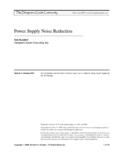Transcription of Working Voltage Ratings Applied to Inductors
1 Document 712-1 Revised 07/25/08 Why Voltage Ratings Are Not Specified on Inductor Data SheetsWorking VoltageRatings Applied toInductorsIntroductionVoltage Ratings are often specified for many electroniccomponents, including capacitors, resistors and inte-grated circuits, but rarely for Inductors . This articleaddresses the reasons why Working Voltage Ratings arenot typically published for are challenges to determine Voltage Ratings forinductors, either by testing or calculation. Inductors donot support dc or low frequency Working voltages un-less the inductance is high (typically >1 mH). Testing toverify Working Voltage can be difficult and should beapplication dependent. The various ways Inductors aremade, and the stresses of processes like wire bending,make calculating a theoretical Voltage rating article presents these issues to make it easier tochoose an inductor most appropriate for the of Voltage RatingThe Voltage rating of an inductor is the maximum volt-age that can be Applied to the terminals without causingarcing or insulation breakdown.
2 Voltage above the maxi-mum rating may cause short circuits between turns,through the insulation, or from the windings to core large number of construction variables turn count,wire insulation type and thickness, the layering of thewindings, bending or forming crossover leads makesit difficult, if not impossible, to calculate the theoreticalvoltage limit of an example, there are standard test methods for de-termining the Voltage rating of film insulated magnetwire, which generally has a Voltage rating in the hun-dreds, if not thousands, of volts. This rating can easilybe compromised by the wire forming process neces-sary to wind an inductor. Magnet wire can be stressed,crazed or nicked, even in a carefully controlled manu-facturing environment.
3 A small scratch in the wire cancause arcing or breakdown at a Voltage much lowerthan the wire "catalog" rating. To calculate a rating thatincludes these variables is not MethodsA hipot (high potential) test is not sufficient to determineinductor Working Voltage . Hipot tests are used to deter-mine primary to secondary isolation within transform-ers, and can be used to determine isolation from windingsto case or windings to ground. However, traditionalhipot tests cannot be used to determine a terminal-to-terminal Voltage rating for inductor operation, V = L di/dt clearly implies thatlarge dc Voltage (or ac line Voltage ) cannot be im-pressed across the terminals of an illustrate, the 10 H power inductor CoilcraftMSS1038-103 has a dc resistance rating of a traditional 500 Vdc hipot test were Applied to theterminals of this inductor, it would be like applying500 V to a length of wire that has a resistance Ohms.
4 By Ohm's Law, to supply 500 V Ohms requires a source capable of providingmore than 14,000 Amps. While this seems silly, it doesillustrate the problem. Testing for Voltage breakdown isreally determining when high Voltage causes a shortcircuit. To a traditional hipot tester, the inductor isalready a short circuit!In order to test for insulation breakdown or arcing, it isnecessary to induce a Voltage pulse, spike or ringingacross the inductor. Such induced Voltage or surgetesting is possible. The technique is well establishedand commercial testers are available. However, theinduced Voltage depends on the inductor storing andsustaining a resonant energy, which is generally onlyeffective for inductance values greater than 1 mH, leav-ing out the vast majority of Inductors except thosedesigned for line frequency induced Voltage that an inductor can withstanddepends on the type of wire insulation, the number andlayering of turns and other factors such as proximity toa conductive core, distance between terminals and theproperties of insulating materials such as the CTI (Com-parative Tracking Index).
5 Therefore it is likely that evenwithin a series of Inductors , each inductance valuewould have a different Voltage , it is difficult to extrapolate from inducedvoltage testing to predict actual insulation breakdown inDocument 712-2 Revised 07/25/08a specific application. Voltage arcing or breakdownvaries depending on environmental factors such asdust or humidity and on operating conditions such asthe shape of the pulse wave. Generally signals withsharp rise times can cause arcing at a lower voltagethan constant or slowly rising (The Good News)It might seem that choosing an inductor is nearly im-possible. The good news is that all the factors thatmake it difficult to test or calculate an inductor voltagerating make it unnecessary to test.
6 The vast majority ofapplications require Inductors to be operated at verysmall Working voltages - usually just a few volts. Re-member, most Inductors work by impeding current flow,not through high Voltage induction. Almost all commer-cial Inductors are good for a few volts or even tens ofvolts with no worries. So for most applications, inductorvoltage rating is not a applications that operate from high line voltages orwork by induction of high Voltage across the winding, itis necessary to consider the possible breakdown of theinductor windings. In these cases it is recommendedthat the specific application be discussed with the in-ductor designer/manufacturer and a test plan devel-oped to ensure the suitability of the inductor.






